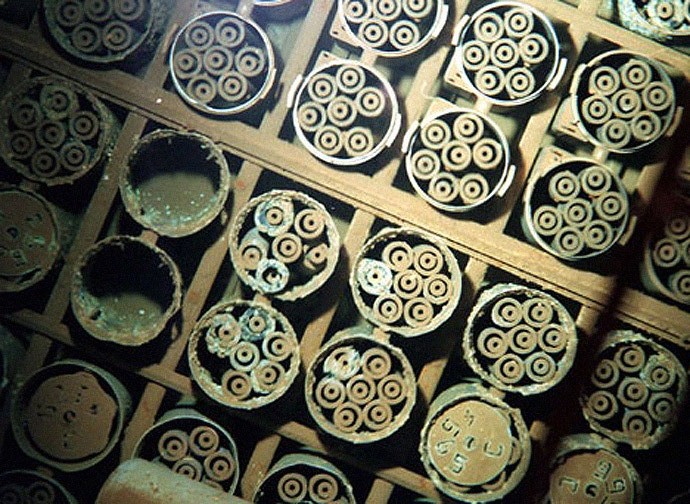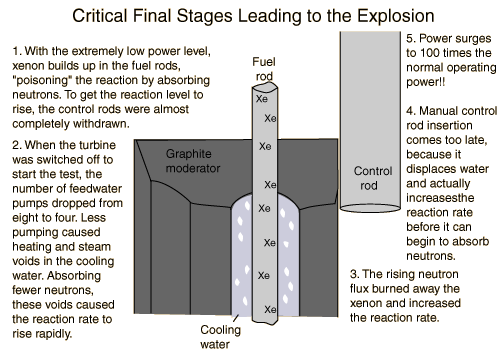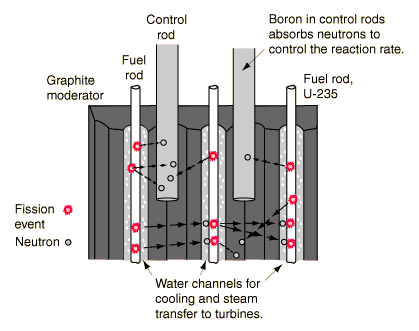
Core Catching
One of the worst accidents in American nuclear history occurred in 1979 at Three Mile Island, located in Pennsylvania. As a result of a series of mechanical and human errors, the reactor core containing the nuclear fuel, which is normally covered in cooling water, was actually uncovered for an unspecified period of time. Before the flow of water could be restored, about half of the nuclear fuel had melted.
The diagram from the Nuclear Regulatory Commission’s website shows what the reactor core “theoretically” looked like immediately after the meltdown. Even though half of the nuclear fuel in the reactor vessel was reduced to a molten mass, none of it escaped the reactor vessel or the containment building, thus avoiding a much more serious disaster.
But what would have happened if the nuclear fuel actually did melt through the bottom of the reactor vessel? At least one report, titled “The President’s Commission on the Accident at TMI,” chaired by John G. Kemeny, theorizes that the nuclear fuel still would have been contained inside the containment building that surrounds the reactor vessel. This commission, also known as the Kemeny commission, was formed two weeks after the TMI accident (at the order of the President) and was tasked with investigating the events that unfolded at TMI. The report theorizes that if the molten core had melted through the reactor vessel, there is a high probability that the containment building and the hard rock on which the containment building was built would have been able to prevent the escape of a large amount of radioactivity.
Long before the TMI accident, nuclear plant designers were already placing systems below the reactor vessel in case of just such an emergency – the melting of the nuclear core. These systems are sometimes called core catchers, since they are designed to catch the flowing molten core that has melted through the metal reactor vessel. These systems continue to evolve and grow more complex as new materials are discovered and researched.
For example, U.S. Patent No. 4,036,688, issued on July 19, 1977, and owned by the United States government, describes a system where the melted core is funneled onto magnesia and graphite bricks layered below the reactor vessel.
As can be seen in the diagram from the patent, a molten reactor core melts through the bottom of the reactor vessel (10) and flows into a funnel (14) made of carbon steel. The funnel (14) directs the molten core to the core debris receptacle (16), whose primary purpose is to prevent the molten core from forming a geometry that would result in a critical mass, resulting in an unwanted fission chain reaction.
The core debris receptacle (16) includes a center dome (24), made of blocks of alumina, as well as tantalum rods (26). Both tantalum and alumina have high melting points and are highly neutron absorbent. The center dome (24) disperses the molten core so that it spreads out over a large surface area thus preventing the formation of a critical geometry. Although the blocks making up the core debris receptacle (16) will reduce nuclear fission reactions in the molten debris, they will eventually melt and combine with the molten debris as it flows into the bed (18) area. The bed (18) contains bricks of magnesia which are designed to melt and mix with the molten core in order to further dilute the amount of nuclear fuel in the molten debris.
The walls of the bed (18) are lined with a layer of heat-resistant graphite blocks (30), which have cooling pipes embedded in them (not shown in the diagram). As the molten debris eventually flows toward the graphite blocks (30), it solidifies as it is cooled by the fluid flowing through the pipes.
Another core catcher system is described in U.S. Patent No. 4,113, 560, issued on September 12, 1978, and assigned to Massachusetts Institute of Technology. As can be seen in the diagram from the patent, a bin (7) located beneath the reactor core (1) contains a bed of graphite particles (6). Since graphite dissipates heat rapidly, the molten core would initially be cooled as heat is transferred from the molten core to the graphite particles. As the molten core begins to cool, it begins to solidify and flows more slowly through the bed of graphite particles (6). The patent indicates that the molten material would flow through the graphite particles at a rate of about a foot per hour.
Without intervention, however, the molten material would eventually flow to the bottom of the bin (7) and melt right through it. For this reason, the system also includes an overhead spray (9) combined with a bottom drain (10) in order to circulate cooling water through the particle bed (6). The water could also contain boron, a neutron absorber, which impedes any fission chain reaction in the molten material as it cools and hardens.
Another core catcher design is described in U.S. Patent No. 4,464,333, issued on August 7, 1984, and assigned to Combustion Engineering, Inc.
The diagram from the patent shows the bottom of the reactor vessel (14) enclosed inside concrete walls (12) of the containment building (16). Below the reactor vessel (14) is an array of vertically oriented water-cooled tubes. Pressurized water flows into the array through the inlet tube (18), then flows through the vertical cooling tubes before exiting via the outlet tube (30). The exterior of the vertical tubes are coated with a heat-resistant material, such as a ceramic or graphite matrix to resist melting from the heat of the molten core.
The inside of the vertical tubes are coated with a neutron absorbent material in order to prevent the neutrons emitted from the molten fuel from being reabsorbed by the fuel, thus preventing a sustained fission chain reaction. The water flowing out of the array via the outlet tube (30) is directed to a heat exchanger (e.g., such as cooling towers) located outside of the reactor containment vessel (16).
Another core catcher design is described in U.S. Patent No. 4,643,870, issued on February 17, 1987, and assigned to the Department of Energy. The diagram from the patent depicts a core meltdown situation, where the core debris (46) has melted through a hole (44) in the bottom of the reactor vessel (34). The core debris (46) comes to rest on a 3 foot thick metal basemat (28) that extends 200 feet outwards from the wall of the reactor vessel (34).
The long length of the basemat (28) helps to dissipate heat transferred to it from the core debris (46). Underneath the basemat (28) are several layers of sand and gravel (32a-d). The top layer (32a) is a 1 foot layer of fine sand, followed by a 1 foot layer (32b) of course sand, followed by 4 foot layer (32c) of fine gravel, followed by a 6 foot layer (32d) of coarse gravel. Two sets of perforated pipes (50, 52) runs through the layers of sand and gravel. One of the pipes (52) carries cooling water to the heated area, which quickly turns the water to steam. The steam is then carried away by the other pipe (50), and is vented some distance from the reactor vessel. Metal pilings (30), extending downwardly and outwardly from the bottom of the reactor, supports the reactor vessel during a meltdown condition. The metal pilings (30) also absorb a substantial amount of heat which then travels down the length of the metal piling (30) away from the reactor vessel.
Another core catcher design is described in U.S. Patent No. 6,658,077, issued on December 2, 2003, and assigned to Areva NP GMBH. The diagram from the patent shows the bottom of the reactor vessel (8) with the core catching system below it. If the conditions for a core meltdown are present, pressurized water held in the storage tank (9) is immediately pumped though a coolant line (5) and is disbursed through multiple coolant lines (4). The water then fills a porous layer (3) made of porous concrete and/or ceramic, which may also contain particles of steel or iron. A sealing layer (7) made of plastic or metal encases the porous layer (3) so that the water remains pressurized once all the cavities of the porous layer (3) have been filled. A layer of concrete (6) having a low melting point sits on top of the sealing layer (7). The purpose of the layer of concrete (6) is to melt and mix into the molten core so that when the molten mixture subsequently melts through the sealing layer (7) and comes into contact with the water in the porous layer (3) the molten mixture is immediately solidified, fragmented and cooled.
A complex core catching system is described in U.S. Patent Publication No. 20090116607, issued on May 7, 2009, assigned to the Korea Atomic Energy Research Institute.The system includes a molten core retention tank (20) situated below the reactor vessel (10). A cooling water storage tank (40) and a compressed gas tank (30) is connected to the retention tank (20) through a section of piping called the mixer (50). In the event of a core meltdown, a valve (41) opens and water begins flowing by gravity from the water storage tank (40). At the same time, a valve (31) opens releasing the inert gas from the gas tank (30), which then mixes with the water in the mixer (50) portion of the piping. The water cools the molten material in the retention tank (20), while the inert gas prevents a possible steam explosion caused by the water suddenly coming into contact with the hot molten material.
Because all of the components shown in the diagram are enclosed in a reactor containment building, the steam produced from the water contacting the molten core (left-hand side of the diagram) will begin to condense on cooler surfaces. For example, water is likely to condense on the outer surface (1) enclosing the water storage tank (40) - as can be seen on the upper right-hand side of the diagram. As water condenses, it will flow through a filter (61) and into an intermediate storage tank (60). This tank (60) refills water depleted from the water storage tank (40) through piping (62) connecting the two tanks. This ensures an adequate supply of cooling water to remove heat from the molten core in the retention tank (20).
Fortunately, no core catching device has actually been utilized in an operating reactor plant. Most nuclear plants have layered protection systems in place that can quickly determine if a dangerous conditions is approaching and prevents it. The core catching mechanisms are meant to be the very last line of defense when these systems, for some reason, fail. However, the lack of actual physical testing of these core catchers caused concern in the report by the Kemeny commission.
 Spent nuclear fuel, occasionally called used nuclear fuel, is nuclear fuel that has been irradiated in a nuclear reactor (usually at a nuclear power plant) to the point where it is no longer useful in sustaining a nuclear reaction.
Spent nuclear fuel, occasionally called used nuclear fuel, is nuclear fuel that has been irradiated in a nuclear reactor (usually at a nuclear power plant) to the point where it is no longer useful in sustaining a nuclear reaction.






















